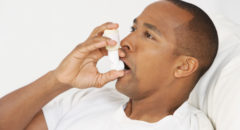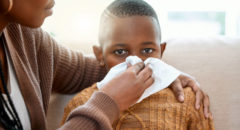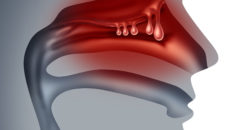
You’re congested. You feel pressure around your eyes, cheeks and forehead. And your head is throbbing. It feels like a sinus headache — but don’t jump to conclusions.
Headaches often accompany sinusitis, a condition in which the membranes lining the sinuses become swollen and inflamed. But many people who assume they have sinus headaches actually have migraines or tension headaches.
When headaches caused by sinusitis do occur, proper diagnosis and treatment are the keys to relief.
Symptoms of Sinus Headaches
Sinus headache symptoms may include:
- Pain, pressure, and fullness in your cheeks, brow or forehead
- Pain may worsen when you bend forward or lie down
- Yellow-green or blood-tinged nasal discharge
- Sore throat
- Fever
- Cough
- Fatigue
So what’s the confusion with migraines? The signs and symptoms of the two types of headaches often overlap. Migraine pain often gets worse when you bend forward, and migraines can be accompanied by various nasal signs and symptoms — including congestion, facial pressure, and a clear, watery nasal discharge.
Sinus headaches, however, usually aren’t associated with nausea or vomiting or aggravated by noise or bright light — all common features of migraines.
Causes
Sinusitis can be caused by colds, allergies, bacterial or fungal infections, an impaired immune system, or structural problems in the nasal cavity. The resulting pressure changes in the sinuses can trigger headaches.
Risk factors
Sinusitis can affect anyone. You may be more likely to develop chronic sinusitis if you have:
- Asthma
- Nasal growths (polyps)
- Allergies to dust, mold or pollen
- A weak immune system
- A condition that affects the way mucus moves within your respiratory system,
such as cystic fibrosis
When to seek medical advice
Consult your doctor if:
- Your symptoms last longer than 10 days
- You have a severe headache, and over-the-counter pain medicine doesn’t help
- You have a fever greater than 100.5 F (38 C)
Tests and diagnosis
The cause of headaches can be difficult to determine. The doctor will ask questions about your headaches and do a physical exam. Be sure to mention if you’ve had a recent cold, if you have allergies and if you smoke. These factors may precipitate or contribute to acute sinusitis.
Tender sinuses may be one sign of sinusitis. The doctor may use a thin tube with a light (endoscope) to examine your nasal passages. He or she may also test mucus samples from inside your nose for evidence of a bacterial or fungal infection.
Sometimes imaging studies such as CT or MRI scans are recommended as well. CT scans use a computer to create cross-sectional images (like slices) of your brain and head (including your sinuses) by combining images from an X-ray unit that rotates around your body. With MRIs, a magnetic field and radio waves are used to create cross-sectional images of the structures within your brain.
Treatments and drugs
If you’re diagnosed with sinusitis, your doctor may recommend antibiotics. Be sure to finish the entire course of medication you are prescribed- even if your signs and symptoms disappear before all the pills or capsules are gone. This is the only way to eradicate the germs causing the infection. If the sinusitis is related to inflammation or allergies, your doctor may prescribe corticosteroid nasal sprays or pills.
As the sinus infection clears up, the sinus headaches should disappear. In the meantime, over-the-counter pain relievers, decongestants and saline nasal spray might help you feel better. Use these products only as directed. It may help to drink plenty of fluids as well.
If a structural problem in your nasal cavity is contributing to sinusitis or sinus headaches, surgical correction may be recommended.
Prevention
To reduce the risk of sinusitis, keep your sinuses healthy.
- Wash your hands often. Soap and water can help you avoid the upper respiratory infections that can lead to sinusitis. You may want to ask your doctor about a yearly flu vaccine as well.
- Avoid irritants. Avoid cigarette, cigar and pipe smoke. These and other air pollutants can cause your sinus membranes to swell.
- Use a humidifier. Adding moisture to dry indoor air can help prevent sinusitis — but don’t overdo it. High indoor humidity can promote mold and dust mite growth in your home. Be sure the humidifier is clean and kept free of mold.
By Mayo Clinic Staff
© 1998-2009 Mayo Foundation for Medical Education and Research (MFMER).
All rights reserved. A single copy of these materials may be reprinted for
noncommercial personal use only. “Mayo,” “Mayo Clinic,” “MayoClinic.com,”
“EmbodyHealth,” “Reliable tools for healthier lives,” “Enhance your life,” and
the triple-shield Mayo Clinic logo are trademarks of Mayo Foundation for Medical
Education and Research.
DS00647








